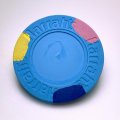Eloe2000
Straight Flush
I had not been able to find much info on milling out Paulson inlays previously, and what little info I did indicated it was not possible. I have bought some junk chips to try traditional murdering with a razor and NPR etc and it was a nightmare. There is zero chance I would proceed with even murdering a single rack for fracs etc let alone building an entire set by murdering via manual inlay removal. I have also gotten somewhat adept at milling hotstamps which I find incredibly fast and easy once you build a working setup and good jig.
Using a Harbor Freight 8 In. 5 Speed Bench Drill Press and several different size bottom cleaning bits from Amazon I decided to give milling inlaid chips a shot. Overall it is much easier to gauge the appropriate depth to drill compared to milling hotstamps since you can observe the pulling up and stop pressing as soon as the white paper/acrylic material pulls up. It creates much less mess as well since milling solids throws crap everywhere and the inlays come out largely in just several large pieces. I tried milling on several different THC, RHC, and house mold chips and found the end results potentially workable for THCs or other 7/8" house mold chips. The inlays pull right out and leave the same undersurface as you find when manually murdering. The only issue I see is the edge and how the inlay can “pull and tear” and run out of the chip on some of these chips (see the Paris 1). This occurred on only some of the chips and not others. I haven’t seen the raw results of murdered chips so this could happen from that method as well. But it can leave somewhat of a ragged edge when the top layer of the inlay laminate tears out. But it seems to clean up well with something like a file, manually applying a grinding bit by hand, or even a magic eraser.
I am unable to find a bottom planning bit at 1-1/16 which is the exact size needed for RHC chips unfortunately so the results were a mess with 1" bit or too much with a 1-1/8" bit.
I can mill solids at about 30min per rack. I would expect this would take me just slightly longer to mill (40min per rack) with some minor additional clean up time for some of the chips.
I wanted to open a thread to document my results and see if anyone else has tried this and what the results were. Maybe this does not produce desired results or milling isn’t for you, but if you were curious this is what happens when you mill out an inlay with a press. Are there additional downsides that I am not thinking of?
THC/house chips milled with 7/8” bottom cleaning bit – immediately after milling


THC/house chips milled with 7/8” bottom cleaning bit – with sample 7/8” Gear labels





THC/house chip milled with 1” bottom cleaning bit – with 1” Gear label

RHC chips milled with 1-1/4” bottom cleaning bit: – with Gear label


RHC chips milled with 1” bottom cleaning bit - don't do this because RHC inlays are larger at 1-1/16":

Using a Harbor Freight 8 In. 5 Speed Bench Drill Press and several different size bottom cleaning bits from Amazon I decided to give milling inlaid chips a shot. Overall it is much easier to gauge the appropriate depth to drill compared to milling hotstamps since you can observe the pulling up and stop pressing as soon as the white paper/acrylic material pulls up. It creates much less mess as well since milling solids throws crap everywhere and the inlays come out largely in just several large pieces. I tried milling on several different THC, RHC, and house mold chips and found the end results potentially workable for THCs or other 7/8" house mold chips. The inlays pull right out and leave the same undersurface as you find when manually murdering. The only issue I see is the edge and how the inlay can “pull and tear” and run out of the chip on some of these chips (see the Paris 1). This occurred on only some of the chips and not others. I haven’t seen the raw results of murdered chips so this could happen from that method as well. But it can leave somewhat of a ragged edge when the top layer of the inlay laminate tears out. But it seems to clean up well with something like a file, manually applying a grinding bit by hand, or even a magic eraser.
I am unable to find a bottom planning bit at 1-1/16 which is the exact size needed for RHC chips unfortunately so the results were a mess with 1" bit or too much with a 1-1/8" bit.
I can mill solids at about 30min per rack. I would expect this would take me just slightly longer to mill (40min per rack) with some minor additional clean up time for some of the chips.
I wanted to open a thread to document my results and see if anyone else has tried this and what the results were. Maybe this does not produce desired results or milling isn’t for you, but if you were curious this is what happens when you mill out an inlay with a press. Are there additional downsides that I am not thinking of?
THC/house chips milled with 7/8” bottom cleaning bit – immediately after milling
THC/house chips milled with 7/8” bottom cleaning bit – with sample 7/8” Gear labels
THC/house chip milled with 1” bottom cleaning bit – with 1” Gear label
RHC chips milled with 1-1/4” bottom cleaning bit: – with Gear label
RHC chips milled with 1” bottom cleaning bit - don't do this because RHC inlays are larger at 1-1/16":
Attachments
Last edited:

